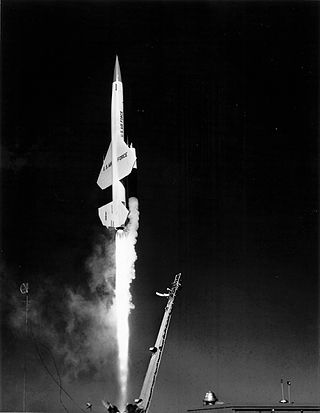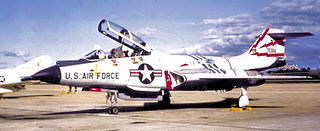Civilian use
| External image | |
|---|---|
In 2009 the 187-acre (1 km2) former missile launch complex was being used as a county impound lot and county/FBI shooting range. [8]
The Suffolk County Air Force Base Missile Annex (SAGE codename "BED") [1] is a Formerly Used Defense Site (NY29799F12240/C02NY0714 [2] ) on Long Island ( 40°49′54″N72°40′59″W / 40.8317708°N 72.6831837°W ) that was a CIM-10 Bomarc missile complex during the Cold War, 2 mi (3.2 km) west of Suffolk County Air Force Base. [3] Planned in 1955 for completion in February 1960 [4] and activated as the 2nd operational BOMARC complex on 1 December 1959 (4 missiles by 1 January), [5] the annex was part of the New York Air Defense Sector defenses. The annex included a Launch Area with 56 Mode II Launcher Shelters in 2 flights (e.g., 2 compressor buildings were available to simultaneously get 2 missiles to the "Standby" stage prior to "Fire-up".) [6]
The Missile Support Area included offices[ citation needed ] of the Base Commander (Col Fred G. Hook, Jr. in 1959), an OOAMA representative, and the Commander of the 6th Air Defense Missile Squadron; while Boeing Airplane Company support was from an office 5 mi (8.0 km) north in Riverhead, New York. [6] Military police operated from a Security Control and Identification building at the SSW entrance to the annex from Old Country Road. Two flights of missile maintenance airmen used the Assembly and Maintenance (A & M) Shop for preparing newly received missiles, repairing BOMARCs that malfunctioned, and periodic recycling. "Missile Recycle" for 6 mo/2 yr component replacement from "ready-storage" used 5 A & M Shop stations after the missile had been transported to the Main Shop Room following defueling and warhead removal at the Launcher Shelter and decontamination at the Fuel Facility. [6] : 6.14 The A & M Shop with 22 rooms included a "Control Room",[ specify ] and a Telecommunication (TELCO) Room with 2 SAGE Digital Data Receivers and a Digital Data Transmitter for communicating missiles' status to the remote launch control center in New Jersey.
The Interceptor Missile Squadron Operations Center (IMSOC) in the A & M Shop next to the TELCO Room was connected to the "Coaxial Distribution System" for communicating with Electrical Launching Equipment (ELE) in each Launcher Shelter's equipment room. The IMSOC used the "Prelaunch Command System" with a Squadron Supervisor's Station in the IMSOC that included "a desk-type console" with manual controls for acknowledging SAGE "alert orders and other commands". The console controlled missile warm-up (e.g., 2 minutes for IM-99A rocket fuel while 30 seconds was needed for IM-99B: [7] arming of the igniter & activation of gyros, seeker, fuze, etc.) and to maintain the BOMARC at "Standby" (warmed-up & erected) until "Fire-up" [6] by a remote Senior Director's keyed console (fire button) at the launch control center (Weapons Director room) at McGuire DC-01, which also was the launch control center for the missile complex on Fort Dix. The console then displayed whether the missile transitioned to the "Launch" or "Malfunction" stage, which determined the subsequent squadron operation needed at the Launcher Shelter (checkout of the empty shelter or deactivation of the faulty missile).
| External image | |
|---|---|
In 2009 the 187-acre (1 km2) former missile launch complex was being used as a county impound lot and county/FBI shooting range. [8]

The Boeing CIM-10 Bomarc was a supersonic ramjet powered long-range surface-to-air missile (SAM) used during the Cold War for the air defense of North America. In addition to being the first operational long-range SAM and the first operational pulse doppler aviation radar, it was the only SAM deployed by the United States Air Force.

Kincheloe Air Force Base was a United States Air Force (USAF) base during the Cold War. Built in the Upper Peninsula of Michigan in 1943 during World War II, the base was in service until 1977.

Francis S. Gabreski Air National Guard Base is an air defense military installation located at civilian public-use Francis S. Gabreski Airport, located just north of Westhampton Beach, New York. It is currently the home base of the New York Air National Guard's 106th Rescue Wing.

Aerospace Defense Command was a major command of the United States Air Force, responsible for air defense of the continental United States. It was activated in 1968 and disbanded in 1980. Its predecessor, Air Defense Command, was established in 1946, briefly inactivated in 1950, reactivated in 1951, and then redesignated Aerospace rather than Air in 1968. Its mission was to provide air defense of the Continental United States (CONUS). It directly controlled all active measures, and was tasked to coordinate all passive means of air defense.

The 21st Air Division is an inactive United States Air Force organization. Its last assignment was with Tactical Air Command, being stationed at Griffiss Air Force Base, New York. It was inactivated on 23 September 1983.

The 35th Air Division is an inactive United States Air Force organization. Its last assignment was with Air Defense Command, assigned to First Air Force, at Hancock Field, New York. It was inactivated on 19 November 1969.

The Eastern Air Defense Sector (EADS) is a United States Air Force unit of Air Combat Command (ACC), permanently assigned to the North American Aerospace Defense Command (NORAD). A joint, bi-national military organization, EADS is composed of US and Canadian military forces, federal civilians and contractors. It is located at the Griffiss Business and Technology Park in Rome, New York, the former Griffiss Air Force Base. EADS is a subordinate command of the First Air Force and Continental NORAD Region, located at Tyndall Air Force Base in Florida.

The Washington Air Defense Sector (WaADS) is an inactive United States Air Force organization. Its last assignment was with the Air Defense Command (ADC) 26th Air Division, being stationed at Fort Lee Air Force Station (AFS), Virginia. It was inactivated on 1 April 1966.

The Syracuse Air Defense Sector (SADS) is an inactive United States Air Force organization. Its last assignment was with the Air Defense Command (ADC) 26th Air Division at Hancock Field, New York.

The 46th Tactical Missile Squadron is an inactive United States Air Force unit, formed by the consolidation of two inactive units in September 1985.
The SAGE radar stations of Air Defense Command were the military installations operated by USAF squadrons using the first automated air defense environment and networked by the SAGE System, a computer network. Most of the radar stations used the Burroughs AN/FST-2 Coordinate Data Transmitting Set (CDTS) to automate the operator environment and provide radar tracks to sector command posts at SAGE Direction Centers (DCs), e.g., the Malmstrom Z-124 radar station was co-located with DC-20. The sector/division radar stations were networked by DCs and Manual Control Centers to provide command, control, and coordination for ground-controlled interception of enemy aircraft by interceptors such as the F-106 developed to work with the SAGE System.
The Niagara Falls Air Force Missile Site was a Cold War USAF launch complex for Boeing CIM-10 Bomarc surface-to-air missiles. It was operated by the 35th Air Defense Missile Squadron. Equipped only IM-99Bs, the site had 48 Model IV "coffin" shelters, after an initial design with a secure area of ~20 acres (8.1 ha) to have 28 shelters. Launch control for the site's missiles was by central NY's "Hancock Field combined direction-combat center" (CC-01/DC-03) at Syracuse, New York. DC-03 was operational on December 1, 1958;

The 6th Air Defense Missile Squadron was an air defense unit of the United States Air Force. It was assigned to the New York Air Defense Sector of Aerospace Defense Command, at Suffolk County Air Force Base, New York, where it was inactivated on 15 December 1964. The squadron had its headquarters at Suffolk County Air Force Base, while the firing batteries of the squadron were at the nearby Suffolk County Air Force Base Missile Annex.
The 3215th Drone Squadron is a discontinued United States Air Force unit. It was last active with the 3205th Drone Group at Patrick Air Force Base, Florida, where it was discontinued on 22 December 1958.

The 4751st Air Defense Missile Squadron is a discontinued United States Air Force unit. It was last active with Air Defense, Tactical Air Command (ADTAC), based at Eglin Air Force Base, Florida. It was inactivated on 30 September 1979.

The Fort Heath radar station was a USAF radar site and US Army Missile Master installation of the joint-use site system (JUSS) for North American Air Defense at a former coastal defense site. The Cold War radar station had 2 USAF AN/FPS-6B height finding radars, 2 Army AN/FPS-6A height finders, an FAA ARSR-1 radar emplaced 1958-9, and an Army nuclear bunker. Arctic Towers were the pedestals for the FPS antennas and radomes, while the Air Route Surveillance Radar was on a 50-foot extension temperate tower adjacent to the Federal Aviation Administration building.

BOMARC Site RW-01 is a 75-acre (30 ha) fenced-off site contaminated primarily with "weapons-grade plutonium (WGP), highly-enriched and depleted uranium." On 7 June 1960 an explosion in a CIM-10 Bomarc missile fuel tank caused the accident and subsequent contamination. The explosion occurred at Launcher Shelter 204, McGuire AFB, Ocean County, New Jersey, approximately 16.1 miles (25.9 km) south-southeast of Trenton, New Jersey. Launcher Shelter 204 was one of fifty-four located at McGuire AFB, operated by the 46th Air Defense Missile Squadron.
Ground-to-Air Transmitter Facilities were surface-to-air missile radio uplink stations of the United States Air Force.
The Westinghouse AN/GPA-35 Ground Environment was a United States Air Force surface-to-air missile weapons direction system. It was used for launch and steering during CIM-10 Bomarc tests during the Cold War. The command guidance system manufactured by Westinghouse Electric Corporation used Bendix AN/FPS-20 Radar data to track the missile. Lincoln Laboratory Division 6 had an AN/GPA-35 Study Group for integrating the AN/GPA-35 into the SAGE System. Notable launches with GPA-35 guidance included:

The Otis Air Force Base BOMARC site was a Cold War USAF launch complex for Boeing CIM-10 Bomarc surface-to-air missiles. Equipped with IM-99Bs, the site had 28 Model IV "coffin" shelters, on 60 acres (24 ha).
…in 1955, to support a program which called for 40 squadrons of BOMARC (120 missiles to a squadron for a total of 4,800 missiles), ADC reached a decision on the location of these 40 squadrons and suggested operational dates for each. The plan was as follows: … l. McGuire 1/60 2. Suffolk 2/60 3. Otis 3/60 4. Dow 4/60..